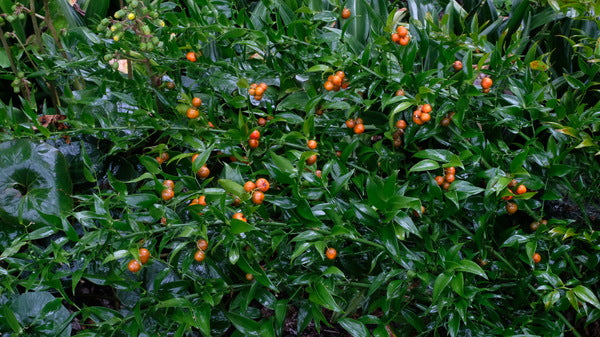How could you not love a plant with the name poet's laurel? The genus danae has a long history in Greek and Roman culture representing praise for a victory or great achievement in the form of a laurel crown. Danae woven-stem wreaths were also bestowed upon revered members of society who, if they then lived off of their past glories, were said to be "resting on their laurels." In Greek mythology, Danae was the daughter of the mythical King Acrisius of Argos, but I'll stop before my train of thought gets derailed.
If you're a gardener and you're from the South, you've no doubt encountered poet's laurel. Poet's laurel, or Danae racemosa to plant geeks, has long been a favorite southern pass-along plant. Pass-along plant is a technical term used to designate plants that aren't economical for most nurseries to grow, so you'll need to beg one from your neighbor. Since poet's laurel takes 5-7 years from seed to produce a saleable plant, the pass-along tag fits perfectly. 
Danae racemosa
Gardeners moving from 'up north' or 'down south' probably have never heard of poet's laurel since its winter hardiness doesn't extend much past Philadelphia to the North and northern Florida to the South (Zone 7-8). Unless, of course, you have a background in flower arranging. Flower arrangers love poet's laurel for its amazing durability as cut foliage. Most of the commercially available floral cut material is flown in weekly from Italy, where most of the massive commercial production takes place...hence the common name, Italian laurel, among the plant arrangers.
Danae is a monotypic genus...a fancy way of saying there ain't but one of 'em. Danae is unique in being evergreen, but without any leaves. Okay, I'll admit that the foliage resembles leaves but, in reality, it's a flattened stem made to look like a leaf, so if you really want to impress your master gardener neighbors, invite them over to see your cladodes. Although danae thrives in the climate of the southeast US, it ain't from around these parts, hailing instead from the Middle East, with its center of distribution in Iran and expanding into the Caucuses. 
Danae racemosa
As a plant, poet's laurel doesn't categorize well. I refer to it as an evergreen perennial although, in the garden, it functions more like a weeping shrub. If you look at the branches on its family tree, you see first cousins that include ruscus (butcher's broom) and asparagus fern, along with slightly more distant relatives, aspidistra (cast iron plant), rohdea (Japanese sacred lily), and liriope (lilyturf).
The 4' long evergreen poet's laurel branches emerge from the base in spring and quickly reach their mature length...after that, these branches never grow again. In the garden, poets laurel makes an evergreen 3' tall x 4' wide clump of arching branches. The cladodes actually flower in the summer, but the tiny white flowers are so minute, few folks have ever seen them. You will know they flowered because, starting in September and lasting through the Christmas holiday season, the branches will suddenly be covered in attractive orange-red, marble-sized fruit.
One of the great benefits to gardening with poets laurel is its love of dry shade... a condition few other plants relish. If you can't find plants to buy, a neighbor's fresh seed can be planted by simply pushing it halfway into the ground. Be patient, since the first year will only produce a root, followed by a single leaf in year two, and two leaves in year three. Eventually, you'll have a nice clump in your woodland garden, but the catchword with poet's laurel is patience!

